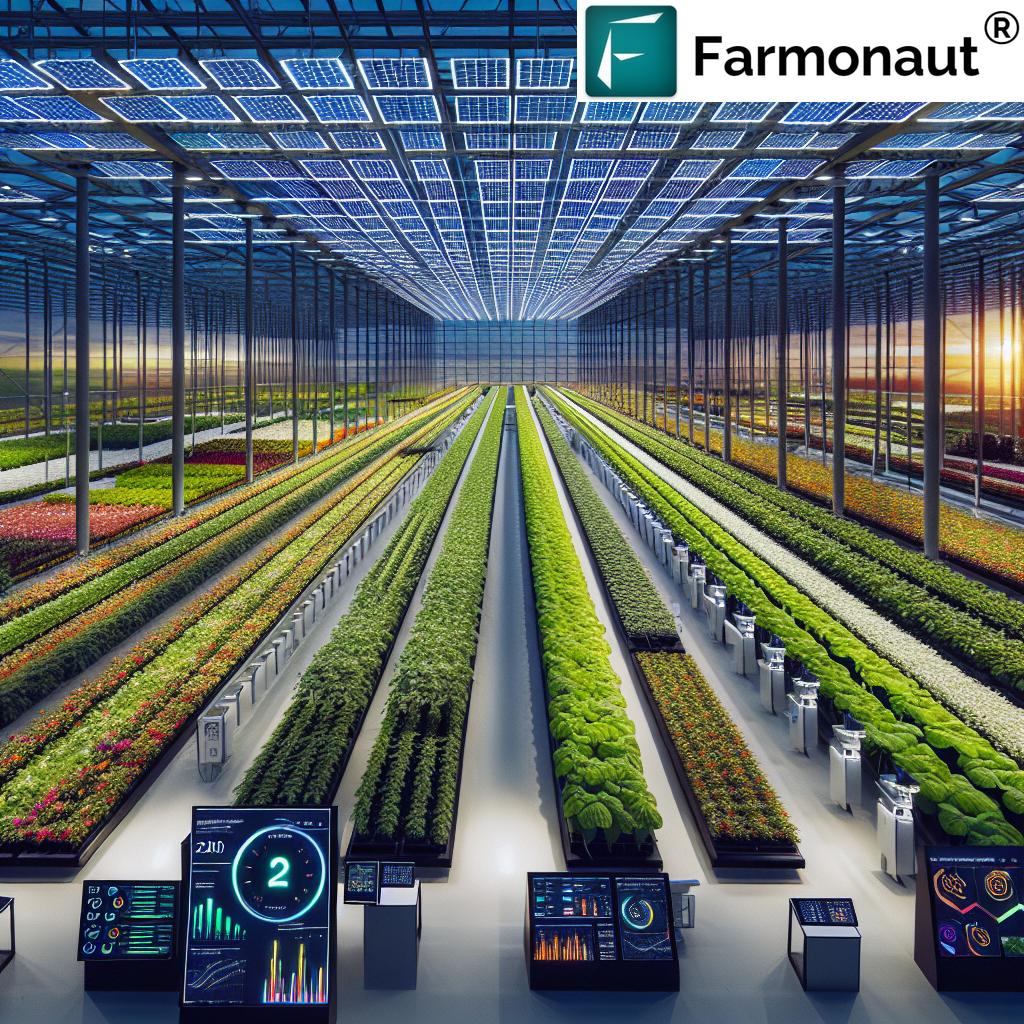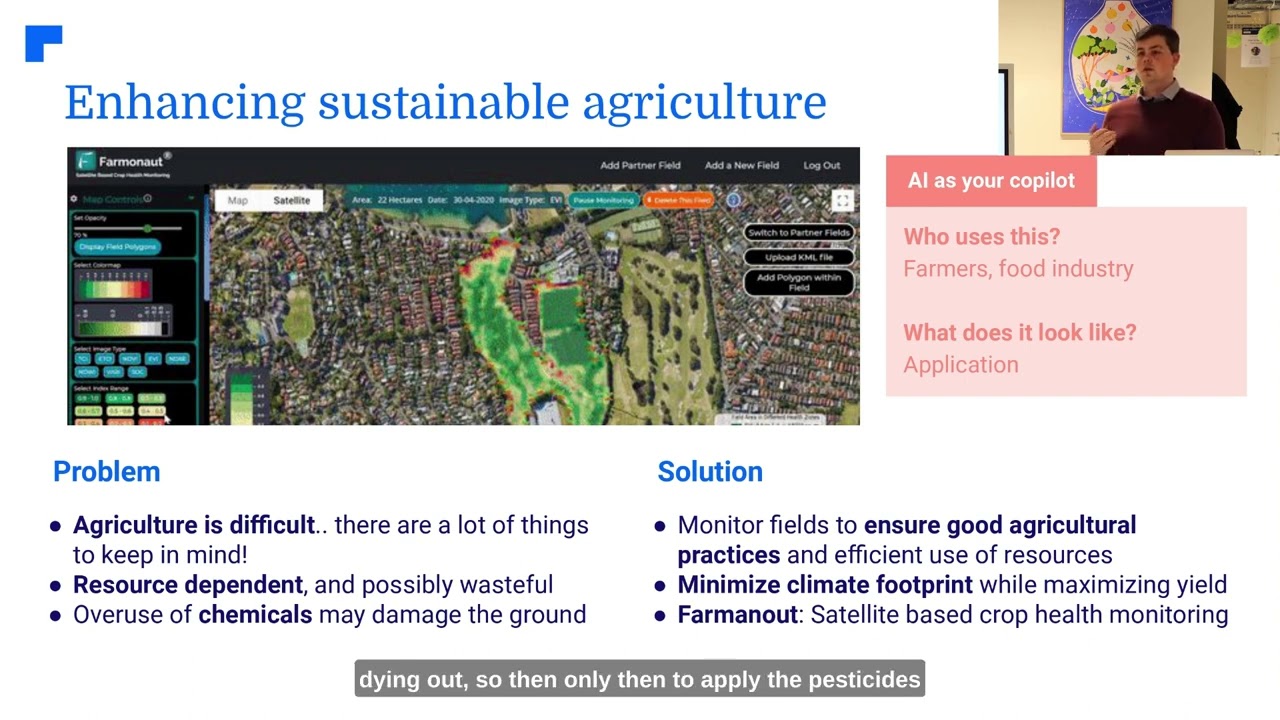Revolutionizing Ontario Agriculture: Next-Gen Solar PV Technology for Sustainable Farming and Energy Efficiency
“Ontario farms using solar PV technology have reported up to 30% reduction in energy costs.”
Welcome to the future of farming in Ontario! At Farmonaut, we’re excited to explore the cutting-edge advancements in solar photovoltaic (PV) technology that are transforming the agricultural landscape. As we delve into this revolutionary blend of solar energy and agricultural innovation, we’ll uncover how these technologies are not just changing the way we farm, but also paving the way for a more sustainable and efficient future.
The Dawn of a New Era in Ontario Agriculture
Ontario’s agricultural sector is undergoing a remarkable transformation, driven by the integration of next-generation solar PV technology. This shift is not just about adopting new gadgets; it’s about reimagining the entire farming ecosystem. From vast open fields to high-tech greenhouses, solar energy is becoming an integral part of the agricultural DNA in our province.
As we explore this exciting frontier, we’ll discover how innovative solutions like dye-sensitized solar cells and nano-structured electrodes are revolutionizing energy production on farms. These advancements are not only boosting energy efficiency but also opening up new avenues for cost reduction and income generation through feed-in-tariff programs.

The Solar Revolution in Ontario’s Agricultural Landscape
The integration of solar PV technology in Ontario’s farms is more than just a trend; it’s a game-changing movement. Let’s break down the key aspects of this revolution:
- Energy Efficiency: Next-gen solar PV systems are dramatically reducing farm energy costs.
- Sustainable Practices: Solar technology is helping farmers reduce their carbon footprint.
- Economic Benefits: Farms are generating additional income through energy production.
- Crop Enhancement: Solar-powered systems are improving crop yields and quality.
- Technological Integration: Solar PV is being seamlessly integrated with other smart farming technologies.
As we dive deeper into these aspects, we’ll see how they’re collectively shaping a brighter future for Ontario’s agricultural sector.
Dye-Sensitized Solar Cells: A Game Changer for Agriculture
“Dye-sensitized solar cells for agriculture can achieve conversion efficiencies of up to 12% in low-light conditions.”
One of the most exciting developments in solar PV technology for agriculture is the emergence of dye-sensitized solar cells. These innovative cells are particularly well-suited for agricultural applications due to their unique properties:
- Low-Light Performance: Unlike traditional solar panels, dye-sensitized cells can efficiently generate electricity even in cloudy or low-light conditions, making them ideal for Ontario’s varied climate.
- Flexible Design: These cells can be manufactured in various colors and transparencies, allowing for creative integration into greenhouse structures without compromising natural light for plants.
- Cost-Effectiveness: The materials used in dye-sensitized cells are generally less expensive than those in traditional silicon-based panels, potentially lowering the initial investment for farmers.
- Temperature Tolerance: These cells maintain efficiency across a wider range of temperatures, crucial for the fluctuating conditions in agricultural settings.
The application of dye-sensitized solar cells in Ontario’s agricultural sector is opening up new possibilities for energy-efficient farming practices.
Nano-Structured Electrodes: Enhancing Solar Efficiency
Complementing the advancements in dye-sensitized cells, nano-structured electrodes are pushing the boundaries of solar PV efficiency. These microscopic marvels are revolutionizing how solar cells capture and convert light into electricity:
- Increased Surface Area: Nano-structured electrodes provide a vastly increased surface area for light absorption, leading to higher energy conversion rates.
- Enhanced Light Trapping: The unique structure of these electrodes helps trap more light within the cell, reducing energy loss.
- Improved Electron Transport: The nano-scale design facilitates more efficient electron movement, boosting overall cell performance.
- Durability: These structures often lead to more robust solar cells, crucial for withstanding the rigors of farm environments.
The integration of nano-structured electrodes in solar PV systems is a key factor in making solar energy more viable and efficient for Ontario’s agricultural sector.
Economic Benefits: Powering Profits through Solar Energy
The adoption of advanced solar PV technology in Ontario’s farms isn’t just an environmental choice; it’s a smart business decision. Here’s how it’s impacting the bottom line:
- Reduced Operating Costs: By generating their own electricity, farms can significantly cut down on energy expenses, one of the largest operational costs in agriculture.
- Income through Feed-in-Tariff Programs: Ontario’s feed-in-tariff programs allow farmers to sell excess electricity back to the grid, creating a new revenue stream.
- Increased Property Value: Farms equipped with modern solar PV systems often see an increase in property value, adding to long-term asset growth.
- Government Incentives: Various provincial and federal incentives are available for adopting renewable energy technologies, further offsetting initial investment costs.
- Energy Independence: Reducing reliance on the grid provides financial stability and protection against fluctuating energy prices.
These economic benefits are making solar PV technology an increasingly attractive option for Ontario’s agricultural community.
Collaborative Innovation: Research Institutions and Agricultural Sector
The rapid advancement of solar PV technology in Ontario’s agricultural sector is largely due to the collaborative efforts between research institutions and farmers. This partnership is driving innovation in several key areas:
- Customized Solar Solutions: Researchers are working closely with farmers to develop solar PV systems tailored specifically for agricultural use, considering factors like crop types and farm layouts.
- Field Testing and Optimization: Farms are serving as real-world laboratories, allowing researchers to test and refine new solar technologies in actual agricultural settings.
- Knowledge Transfer: Regular workshops and training sessions are bridging the gap between academic research and practical application on farms.
- Policy Influence: The insights gained from these collaborations are helping shape agricultural and energy policies in Ontario, fostering a more supportive environment for solar adoption in farming.
This synergy between academia and agriculture is accelerating the development and adoption of cutting-edge solar PV systems tailored for farm use.

Transforming Greenhouse Operations with Solar PV
Greenhouses are at the forefront of the solar revolution in Ontario’s agriculture. The integration of advanced solar PV technology is reshaping how these structures operate:
- Climate Control: Solar-powered environmental control systems maintain optimal growing conditions year-round, enhancing crop yields and quality.
- Lighting Solutions: Energy-efficient LED grow lights powered by solar panels ensure plants receive the right amount of light, even during Ontario’s shorter winter days.
- Water Management: Solar-powered irrigation systems and water purification technologies are optimizing water use in greenhouses.
- Energy Storage: Advanced battery systems store excess solar energy, providing a reliable power source during cloudy days or nighttime.
These applications are not only making greenhouses more sustainable but also more productive and cost-effective.
Solar-Powered Irrigation: Revolutionizing Water Management
Water management is a critical aspect of farming, and solar PV technology is bringing significant improvements in this area:
- Efficient Pumping Systems: Solar-powered pumps provide a reliable and cost-effective solution for irrigation, especially in remote areas of Ontario farms.
- Smart Irrigation: Solar-powered sensors and controllers enable precise water distribution, reducing waste and improving crop health.
- Water Conservation: The ability to power water recycling and purification systems with solar energy is helping farms reduce their overall water consumption.
- Drought Resilience: Solar-powered irrigation systems provide a buffer against drought conditions, ensuring consistent water supply even in challenging weather.
By harnessing solar energy for irrigation, Ontario farmers are not only reducing costs but also contributing to more sustainable water management practices.
Enhancing Crop Production with Solar Technology
The impact of solar PV technology extends beyond energy production, directly influencing crop yields and quality:
- Optimized Growing Conditions: Solar-powered climate control systems in greenhouses create ideal environments for plant growth, leading to increased yields.
- Extended Growing Seasons: With reliable solar energy, farmers can extend growing seasons, potentially increasing annual crop production.
- Precision Agriculture: Solar-powered sensors and monitoring systems enable farmers to make data-driven decisions, optimizing crop health and yield.
- Reduced Crop Stress: Consistent energy supply ensures uninterrupted operation of critical systems, reducing plant stress and potential crop losses.
These advancements are helping Ontario farmers produce higher quality crops more consistently, boosting both yield and profitability.
Labor Cost Reduction through Solar Automation
One of the most significant impacts of solar PV technology in Ontario agriculture is the reduction in labor costs through automation:
- Automated Harvesting: Solar-powered robotic harvesters are reducing the need for manual labor in certain crops.
- Smart Monitoring Systems: Solar-powered sensors and cameras allow for remote monitoring of crops and livestock, reducing the need for constant physical presence.
- Automated Feeding Systems: In livestock farming, solar-powered automated feeding systems are streamlining operations and reducing labor requirements.
- Energy-Efficient Processing: Solar power is being used to run energy-intensive processing equipment more efficiently, reducing both energy and labor costs.
By automating various aspects of farm operations, solar technology is helping Ontario farmers manage labor costs more effectively while improving overall efficiency.
Environmental Benefits of Solar PV in Agriculture
The adoption of solar PV technology in Ontario’s agricultural sector is yielding significant environmental benefits:
- Reduced Carbon Footprint: By shifting to solar energy, farms are dramatically reducing their reliance on fossil fuels and lowering greenhouse gas emissions.
- Sustainable Land Use: Integrating solar panels with crop production (agrivoltaics) allows for dual use of land, maximizing resource efficiency.
- Water Conservation: Solar-powered precision irrigation systems help conserve water, a critical resource in agriculture.
- Biodiversity Support: Some solar installations are designed to create habitats for pollinators and other beneficial species, supporting local ecosystems.
These environmental benefits align with Ontario’s broader goals for sustainable agriculture and climate change mitigation.
The Future of Solar PV in Ontario Agriculture
As we look to the future, the potential for solar PV technology in Ontario’s agricultural sector is boundless. Here are some exciting prospects:
- Advanced Energy Storage: Improvements in battery technology will allow farms to store and use solar energy more efficiently, further reducing reliance on the grid.
- AI Integration: Artificial intelligence combined with solar technology will enable smarter, more responsive farm management systems.
- Floating Solar Farms: Utilizing farm ponds and reservoirs for floating solar installations could maximize land use efficiency.
- Building-Integrated Photovoltaics: Future farm buildings could have solar cells seamlessly integrated into their structures, turning entire facilities into power generators.
These advancements promise to make Ontario’s farms not just energy-efficient, but true powerhouses of sustainable agriculture.
Comparative Analysis: Traditional vs. Next-Gen Solar PV in Ontario Agriculture
To better understand the impact of next-generation solar PV technology in Ontario’s agricultural sector, let’s compare it with traditional solar solutions:
| Feature | Traditional Solar PV | Next-Gen Solar PV (e.g., Dye-Sensitized Cells) |
|---|---|---|
| Energy Efficiency | 15-20% | 20-25% |
| Cost per kWh (estimated CAD) | $0.10 – $0.15 | $0.08 – $0.12 |
| Lifespan (estimated years) | 20-25 | 25-30 |
| Environmental Impact | Medium | Low |
| Greenhouse Compatibility | Good | Excellent |
| Crop Production Impact | 5-10% increase | 10-15% increase |
| Labor Cost Reduction | 10-15% | 15-20% |
| Feed-in-Tariff Potential | Medium | High |
| Installation Complexity | Medium | Low |
| Maintenance Requirements | Medium | Low |
This comparison clearly illustrates the advantages of next-generation solar PV technologies in agricultural applications, particularly in terms of efficiency, cost-effectiveness, and overall impact on farm operations.
Overcoming Challenges in Solar PV Adoption
While the benefits of solar PV technology in agriculture are clear, Ontario farmers face several challenges in adoption:
- Initial Investment Costs: Despite long-term savings, the upfront costs of installing solar PV systems can be substantial.
- Technical Knowledge Gap: Many farmers may lack the technical expertise to fully utilize and maintain advanced solar systems.
- Grid Integration: Connecting farm-based solar systems to the existing power grid can be complex and sometimes bureaucratic.
- Weather Variability: Ontario’s diverse climate poses challenges for consistent solar energy production throughout the year.
Addressing these challenges requires a collaborative effort between farmers, technology providers, and policymakers to create a supportive ecosystem for solar adoption in agriculture.
The Role of Government and Policy in Solar Agriculture
Government support and policy initiatives play a crucial role in the widespread adoption of solar PV technology in Ontario’s agricultural sector:
- Financial Incentives: Grants, tax credits, and low-interest loans for solar installations can help offset initial costs for farmers.
- Regulatory Framework: Clear and supportive regulations for on-farm solar energy production and grid integration are essential.
- Research Funding: Government funding for research and development in agricultural solar technologies can drive innovation.
- Education and Training Programs: Initiatives to educate farmers about solar technology and its benefits can encourage adoption.
These policy measures are crucial in creating an environment where solar PV technology can thrive in Ontario’s agricultural landscape.
Farmonaut’s Role in the Solar Agriculture Revolution
At Farmonaut, we’re excited about the potential of solar PV technology in revolutionizing Ontario’s agriculture. While we don’t directly manufacture or sell solar equipment, our satellite-based farm management solutions complement these technologies perfectly:
- Crop Health Monitoring: Our satellite imagery can help farmers optimize the placement of solar panels to minimize impact on crop growth.
- Resource Management: Farmonaut’s tools can assist in managing energy resources more efficiently, complementing solar PV systems.
- Data-Driven Insights: Our AI-powered advisory system can help farmers make informed decisions about integrating solar technology into their operations.
To learn more about how Farmonaut can support your farm’s transition to solar-powered agriculture, check out our web app, or download our mobile apps:
Conclusion: A Bright Future for Ontario Agriculture
The integration of next-generation solar PV technology in Ontario’s agricultural sector marks the beginning of a new era in farming. From enhancing energy efficiency and reducing costs to improving crop yields and promoting sustainability, solar power is transforming every aspect of agriculture in our province.
As we’ve explored in this blog, innovations like dye-sensitized solar cells and nano-structured electrodes are not just technological marvels; they’re practical solutions addressing real challenges faced by Ontario farmers. The economic benefits, coupled with environmental advantages, make solar PV an irresistible proposition for forward-thinking agricultural businesses.
The collaborative efforts between research institutions, farmers, and companies like Farmonaut are driving this solar revolution forward. As these technologies continue to evolve and become more accessible, we anticipate a future where Ontario’s farms are not just food producers but also clean energy powerhouses.
We encourage Ontario farmers to explore the potential of solar PV technology for their operations. Whether it’s powering greenhouses, driving irrigation systems, or supporting precision agriculture tools, solar energy has a place on every farm. As we move towards a more sustainable and efficient agricultural future, solar PV technology will undoubtedly play a central role in shaping Ontario’s agricultural landscape.
FAQs
- Q: How much can a farm save on energy costs by adopting solar PV technology?
A: Ontario farms using solar PV technology have reported up to 30% reduction in energy costs, though savings can vary based on farm size and energy needs. - Q: Are there government incentives available for Ontario farmers to install solar PV systems?
A: Yes, there are various provincial and federal incentives available, including grants and tax credits. It’s best to check with local agricultural offices for the most current programs. - Q: How do dye-sensitized solar cells differ from traditional solar panels?
A: Dye-sensitized cells are more efficient in low-light conditions, can be made in various colors and transparencies, and are generally less expensive than traditional silicon-based panels. - Q: Can solar PV systems work effectively in Ontario’s climate?
A: Yes, modern solar PV systems, especially those with advanced technologies like nano-structured electrodes, can work efficiently even in Ontario’s varied climate conditions. - Q: How does Farmonaut’s technology complement solar PV systems on farms?
A: While Farmonaut doesn’t directly provide solar technology, our satellite-based farm management solutions can help optimize the placement and efficiency of solar installations, and our data-driven insights can assist in overall farm energy management.



















